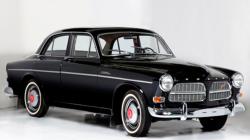 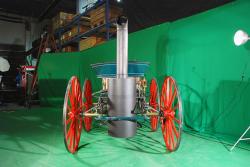 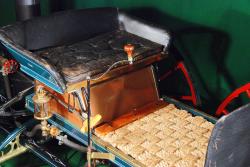 Top: Volvo Canadian, photo courtesy of the Museum of Industry. Middle, bottom: Taylor Steam Buggy, photo courtesy of the Canada Science and Technology Museum. Click image to enlarge |
Article by Brendan McAleer
In 1912, Thomas Wilby and Jack Haney drove across Canada in a clattery four-cylinder REO. They were not friends at the beginning of the trip, and relations were even more strained after two months behind the wheel.
Moreover, their record doesn’t really count, as they had to take several trains and boats because there was no true Trans-Canada highway at the time. It took until 1946 before a pair of airmen, R.A. MacFarlane and K.A. MacGillivary, were able to traverse the entire length of this vast nation. Of course, they left out Newfoundland, so you could argue that one didn’t count either.
Let’s face it: if there’s one thing Canadians aren’t our usual polite and deferring selves about, it’s how proud we are of just how ridiculously huge our country is. There’s even a rather good song about it by the Arrogant Worms.
To get around the place, we use only the finest automobiles, great big cruisers fitted with powerful engines and luxurious suspensions. No, wait, that’s Americans. Canadians like small cars, possibly because we’re such a bunch of cheapskates, or maybe because we need to save our money for new goalie pads.
I love being a Canadian. I love having a flappy head and little beady eyes, and I love being able to swear at bad drivers in two official languages, and I love the fact that you can leave your driveway and drive for a week, and still be in the same dang country. It’s great.
So, on Canada Day, a look through some of our peculiar motoring history at some of the most Canadian cars ever made. To kick things off, we’re going to have to go even further back than Wilby and Haney’s rather grumpy road trip – flip the switch on the Tim Hortons time machine.
Taylor Steam Buggy
Built in Quebec in 1867, Henry Taylor’s steam buggy looks like most very early cars: it’s basically a wagon with a potbellied stove hanging off the back. Powered by a steam engine making an impressive 1.2 hp, it ran on coal and was capable of hitting 24 km/h.
By modern standards, these aren’t exactly thrilling numbers. However, there was one little timbit of information that made the Taylor Buggy quite a wild ride. It didn’t have brakes.
Naturally, it was crashed almost immediately. Happily though, someone thought to keep the parts stored, and the car was restored in the 1960s, and now resides in the Canadian Science and Technology museum. It’s the sort of thing Jasper from Road to Avonlea would have come up with.
Ford Model T
“Now hang on,” I hear you saying, “That’s not Canadian at all!” True, Henry Ford’s ubiquitous little buggy doesn’t seem especially Canuck-oriented, but they did build them here, and we loved them.
While the early part of the motoring century was filled with other popular machines like the Russell 14-28, which had CCM (the bicycle manufacturer) as a parent company, the Model T was a Canadian favourite.
If you pop the hood on a Canadian-built Tin Lizzie, you’ll also note “made in Canada” stamped right on the cylinder head. Also, many of the cars built here were shipped to the Australian market, so were set up to be switched over to right-hand drive – you can tell a Canadian Model T from a distance because it’ll have doors on both sides; for the most part American-built cars only have a passenger-side door.
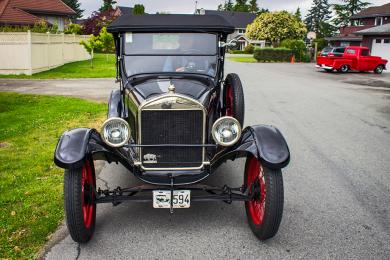 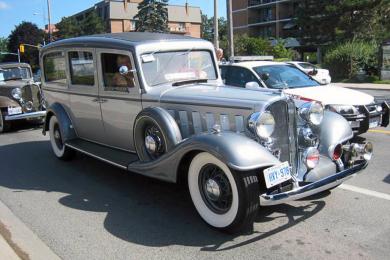 Ford Model T; McLaughlin-Buick 28-496, photo by Jil McIntosh. Click image to enlarge |
McLaughlin-Buick 28-496
Not a commonly known car, the McLaughlin-Buick is the sort of machine you’ll likely only see at car shows. A luxurious vehicle, one was used by Prince Edward and Prince George to tour the country in 1927, as part of the Diamond Jubilee.
Custom built and shaped in Oshawa, the 28-496 came with a smooth, 77-hp straight-six engine sourced from Buick. General Motors had bought Samuel McLaughlin’s company in 1918, and he would go on to be president of GM’s Canadian division until just after WWII ended, and on its board right up until 1960.
When Prince Ed (can I call you Ed? Ted? Eddie baby? No?) became King Edward VIII, he ordered a McLaughlin as his personal limousine. Later, for King George VI and Queen Elizabeth’s 1939 tour, McLaughlin-Buicks were again used. It might not be a common car, but the 28-496 displays our curious Canadian connection to the British Royal family. Buy one and practice your funny wave.
Pontiac Pathfinder
For the common folks, a little less luxury and a little more Pontiac ruggedness. Right up until 1965, Canada existed behind a tariff wall that meant most of the American manufacturers built cars here. At first, the vehicles were mostly identical, but as Canadians began choosing smaller, more basic versions, car makers like Pontiac responded.
Where the Ford Frontenac was a one-year wonder that took a Falcon compact sedan and stuck Maple Leaf badges all over it, the Pontiac Pathfinder was an actual Canadian car. Built from 1953 until 1958, the Pathfinder was a hot seller, and combined Chevrolet and Pontiac elements for something fairly unique. It had a straight-six engine making 115 hp, and was an ideal touring vehicle.
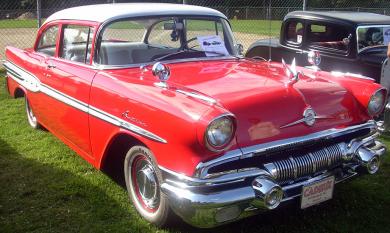 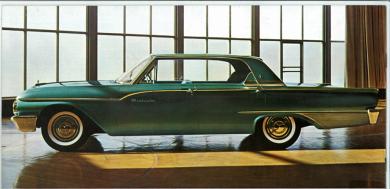 Pontiac Pathfinder; Mercury Meteor Montcalm, photo courtesy GM. Click image to enlarge |
Mercury Meteor Montcalm
One of the longest-running Canadian nameplates, the Meteor Montcalm was essentially just a Ford dressed up in Canadian-friendly duds. However, it would carry right through in production until 1976, making it an ideal car to traverse the newly completed Trans-Canada Highway.
Officially opened in 1962, but taking nearly a full further decade to complete, the Trans-Canada marked a new era of ease in moving about the country, and the Montcalm’s two engine options and big trunk allowed for easy cruising. Over 600,000 of the cars had been owned by Canadian drivers by the time it went out of production.
Volvo Canadian
You can’t get more Canadian than by putting “Canadian” on the rear bumper. Built to withstand the Scandinavian winters, Volvos became very popular with Canadians early on. Some rally successes helped spread the word about these lesser-known Swedish machines, and soon demand was such that Volvo set up a factory in Nova Scotia.
Here they built their Amazon, rebadged as the “Canadian” for our market: you could get it as a coupe, sedan, or wagon. A very tough little car, this Volvo has a lasting fan base even today. Equipped with a stout 90-hp four-cylinder engine, it helped Volvo gain a toehold in the Canadian market.
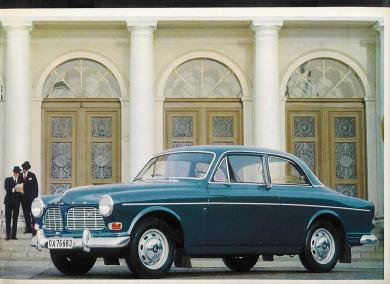 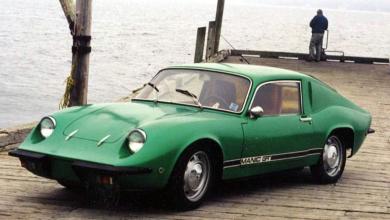 Volvo Canadian, photo courtesy Volvo; Manic GT, photo courtesy of theautounion.net. Click image to enlarge |
Manic GT
Here’s the reason you’re not going to find the Bricklin SV-1 on this list. If we’re going to pick one 1970s oddball, it’s going to be a car that Canadians could actually buy, and the Bricklin was never sold here.
The Manic GT, on the other hand, was built by Canadians, for Canadians. Essentially a copy of the Renault Alpine, it was powered by a 65-hp air-cooled engine. The Manic was light, and actually quite fast, and it handled in the same nimble fashion that helped the Alpine win so many rally victories.
Unfortunately, relying on Renault was a mistake. Despite a brand-new factory in Quebec, and highly skilled workers, the Manic GT failed because the company simply couldn’t get parts fast enough. With few orders filled, it soon filed for bankruptcy. Because its fibreglass-on-frame construction is very difficult to restore, there are hardly any left today. You have to admire its pluck though, especially as a uniquely Francophone automobile.
Hyundai Pony
We’ve covered the Pony before, but it’s worth a mention as it came to Canada in a unique spec. Cheap as anything, it was just the car we craved, and in 1984 immediately became a sales sensation. The best-selling car in Canada two years running, the Pony highlights our Canadian obsession with small, efficient, and inexpensive. Too bad they didn’t build them just a little bit better.
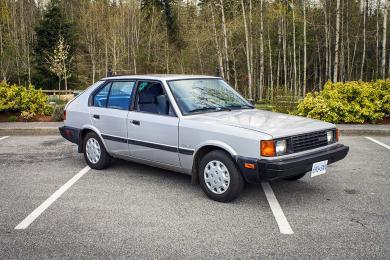 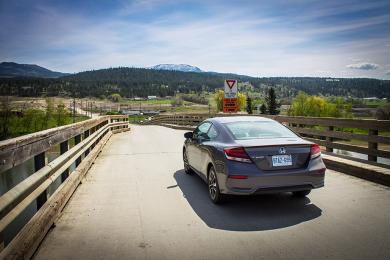 Hyundai Pony & Honda Civic, photos by Brendan McAleer. Click image to enlarge |
Honda Civic
Built in Alliston, Ontario from the 1988 model year, the Civic has currently been Canada’s favourite car for sixteen years running. That’s a heck of an achievement, and while the current Civic is just now bouncing back from a brief rest on its laurels, it’s still a solid buy.
The Civic isn’t the only car built in Canada either. While our manufacturing isn’t at the level it was at before the tariff laws changed in the mid-1960s, we still produce a huge amount of cars, including favourites like the Camaro, the family-hauling Dodge Grand Caravan, the Corolla, the Charger, the Impala, and the Ford Edge. All told, 24 different vehicles are built here, and that excludes specialized machinery from Bombardier, and the like.
Then there are Canada-only models like the Nissan Micra, Chevrolet Orlando and Mercedes-Benz B 250, cars we get that the US doesn’t. Again, it’s all down to our unique focus on buying just what we need and no more.
Whatever you drive, today’s the day to crank up the Stompin’ Tom Connors and hit the highway. It’s a really big country, so get out there and explore it.











